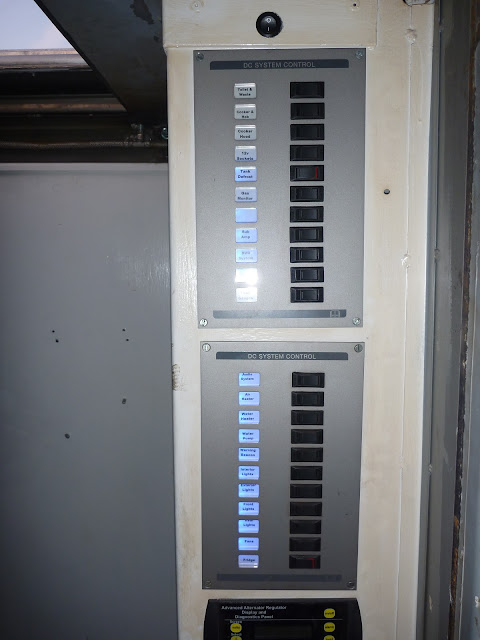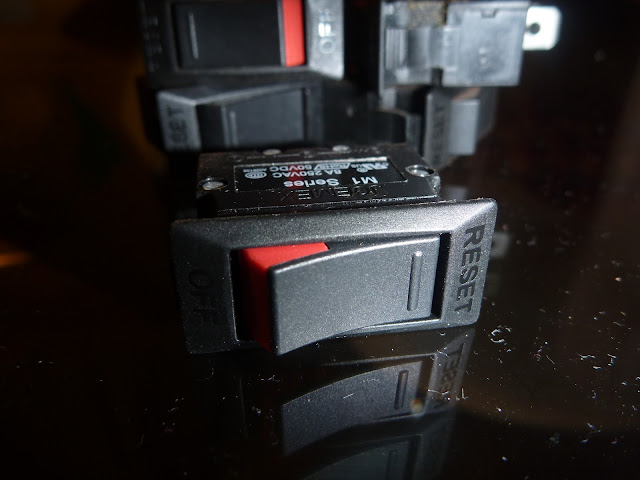
For reasons which I can't really understand, most caravan and motorhome manufacturers still choose to use fuses over circuit breakers, despite AC installers choosing to make the switch more than three decades ago. If you could still buy them, I have no doubt that caravan manufacturers would still use Bakelite switches and rubber wiring. Nevertheless, there are a fair range of circuit breaker panels to chose from, mostly from the world of marine electricals where their use is more common.
I chose to use two 11-way breaker panels from Victron's ESP panel range. I could have used less than 22 circuits, but I would have had to start aggregating various electrical items together in non-intuitive ways. Do the toilet flush, and kitchen extractor fan belong on the same circuit? The Victron panels seem to be less popular than the BEP Marine or Blue Sea Systems panels, despite costing about half that of the BEP Marine panels and about the same as the Blue Sea Systems ones. In my opinion the Victron panels are better looking aesthetically, and I cannot see the alternatives offering anything over the Victron Panels.
When I installed the switch panels, I just wired in the small number of circuits I retained from Jim's orginal electrical installation, and the remaining breakers were left unusused. Below is how the electrical cabinet looked when largely empty; the bus bars for the newly installed panels are on the top right.
Given that I am now begining to install some electrical appliances, I thought it was about time I labelled up each circuit on the panels, and worked out what breaker rating each circuit would require.
From Victron, the 11-way DC panels are fitted with 1 x 20a, 2 x 16a, 5 x 10a and 3 x 5a breakers. The breakers are fairly easy to replace and rearrange, although in most installations it is best to do it before fitting the panels. With a bit of rearranging I managed to make good use of most of the breakers that came fitted, but the bias towards large current circuits meant that I was short of a few smaller breakers. I suspect that the panel was geared more towards 12v installations, as at 24v the sum of the breakers is nearly 3000w. Having worked out which breakers I needed more of, I contacted the nearest distributor to order the extras; I was told they were £20 each.
As regular blog readers will be aware, I am willing to pay for quality when it's necessary, but I hate being ripped off, which is exactly what £20 per breaker felt like. Tagging "marine" on the front of a product seems like a license to add a massive price hike, and this case was clearly no exception. I reckon you could make a decent living by buying items in the automotive section of ebay, and relisting them for twice the price in the marine section.
Suspecting that Victron did not manufacture the breakers themselves, I removed one I planned to replace anyway, and found a manufacturer and part number.
For anyone interested Victron use Joemex M1 series breakers in their ESP switch panels. Joemex manufacture the breakers with a range of options, including LED indicators and printed labels, but I worked out the full product codes to match to the original breakers installed, from the Joemex data sheet . For reference, and in case anyone else reading this is trying to avoid paying through the nose for Victron parts, the options needed to match to the original breakers installed, are:
- Non-illuminated,
- 250VAC/50VDC,
- 9.5mm Solder Lug,
- Black base colour,
- Black rocker colour, and
- Moulded markings
With the correct breakers in hand, I replaced the larger than necessary ones in the panels and labelled the panels up.

I also wired a switch into the backlight circuit so that I can switch it on when necessary (read: showing off).
As discussed on a prevous blog entry, I have a small number of circuits which will operate at 12v, rather than the 24v outputted by the battery bank. To serve these circuits I cut a break in the bus bar supplying DC to the breakers in the top panel, and fed the top seven breakers from a 24v-12v DC voltage dropper.
Excuse the messy wiring, I'll tidy it up in due course.
I can now begin to install some electrical items that are sitting patiently in my living room, knowing that I wont have to rewire the panels again.




This comment has been removed by a blog administrator.
ReplyDelete